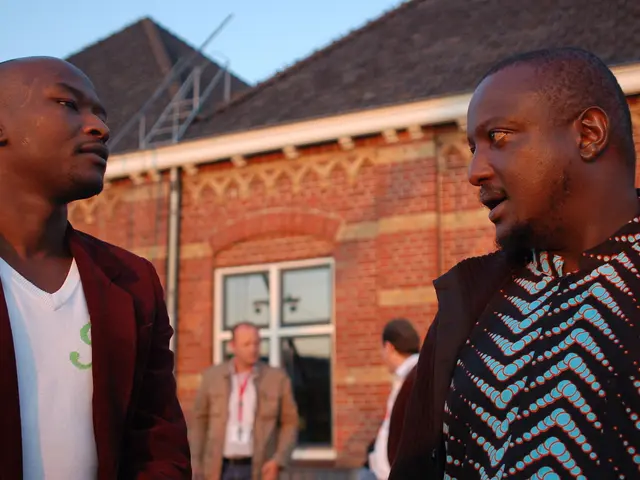LVMH's Not-Typical $1.5 Billion Investment in Formula 1: An Unconventional Luxury Pact
When my preferred luxe tycoon, the legendary Bernard Arnault, chairman of the swanky LVMH Group, watches Max Verstappen zip through hairpin turns at 180 miles per hour during the Formula 1 Bahrain Grand Prix, he's envisioning more than just a speedy race. With a calculated $1.5 billion, 10-year investment, Arnault's backing of this skyrocketing sport represents far more than swank logo placement on swift vehicles. Like his astute sponsorship of the 2024 Paris Olympic Games, this groundbreaking alliance—formed late in '24, coinciding with the sport's 75th anniversary and season—paints a picture of something greater: an intricate dance between LVMH's top-tier brands—TAG Heuer, Louis Vuitton, and Moët & Chandon—each stepping into carefully choreographed roles in luxury's most ambitious sporting investment ever.
Arnault masterfully orchestrated TAG Heuer's takeover of Rolex's role as Monaco's Grand Prix's official timekeeper, seamlessly integrated Louis Vuitton's exquisite trunks as Formula 1 trophy carriers, and ensured Moët & Chandon's ubiquitous presence across newly rebranded races, such as the Formula 1 TAG Heuer Monaco Grand Prix, the 2025 Formula 1 Louis Vuitton Australian Grand Prix, and the 2025 Formula 1 Moët & Chandon Belgian Grand Prix.
These LVMH brands will graze 24 global stages over nine months—stages that drew a collective 1.5 billion television viewers last year, averaging 70 million per race. These viewers include an array of aficionados unfamiliar with Louis Vuitton boutiques or TAG Heuer timepieces. With patterns skewing younger and more multicultural than traditional luxury consumers, it's clear that Arnault aims to cultivate prospective patrons that many luxury brands often overlook, opting instead for deep-pocketed enthusiasts.
Now that Formula 1 has inked deals to make stops in my sunny Miami haunts for the next 15 years, I decided to explore the sport's burgeoning union with luxury first-hand. What I uncovered were strategic partnerships straddling the line between a rich motor-racing heritage, a lifestyle signature, and a tech-savvy fanbase predominantly led by women.
Delving into Aston Martin's F1 Strategy for Heritage Storytelling
"Formula 1 is really having a moment," Rob Bloom, CMO of Aston Martin Formula 1, remarked over a nip of the collectible Glenfiddich 50YO Simultaneous Time, part of the single malt scotch whisky titan's Time Refined collection, and one of the rarest spirits I'd sip that night. "New fans are still discovering Formula 1 today. This boom in popularity attracts newer, younger fans with a female majority, particularly in nations like the USA, which is fantastic to witness."
Following a day racing McLarens at the McLaren Track Driving Event, a MIAMI GRAND PRIX Track Preview Experience & Paddock Tour, both courtesy of Chase Sapphire Reserve, I swapped my driving kicks for heels and a Donna Karan silk frock as I meandered to the Mandarin Oriental for an exclusive dinner with the Aston Martin Aramco Formula One Team. Here, we reveled in Glenfiddich's exclusive portfolio.
This dining soiree was part of Aston Martin F1's multi-year partnership with the scotch brand, formalized at the November Las Vegas Grand Prix. There, Glenfiddich tapped a rare cask from 1959—the very year Aston Martin arrived in Formula 1—to craft a commemorative, limited-edition expression. By blending both brands' roots, they both drew upon each other's legacy to escalate audience growth. In this meticulously orchestrated coupling, an Aston Martin enthusiast and an ardent Glenfiddich connoisseur share a passion for the handcrafted, precision engineering, and heritage, as well as the insatiable desire for innovation and distinction.
"The ambition that exists within the team is that we'll never settle," Bloom explained. "There's that ongoing pursuit of excellence and the continuous quest for improvement. Even after winning a race, the only thing we're thinking about is the next race and the next win. It's sort of addictive, fueling everyone within the team, who all live with this growth mindset."
Under Bloom's knowledgeable marketing command, the brand is leveraging Formula 1's escalating popularity by actively engaging with new audiences through lifestyle integrations and collaborations, such as with Glenfiddich. Beyond merely triumphing on the track, Aston Martin F1's marketing strategy focuses on constantly exalting the brand's image among an ardent community.
He continued, "The appeal of the sport itself is undoubtedly having a moment. It's not just about that technological racing story, the growth mindset, and the unrelenting competition. It's also about an extension into culture and lifestyle, and the fact that Formula 1 seamlessly integrates into everyday life."
This cultural expansion has drastically altered how luxury brands engage in Formula 1 partnerships. "Aston Martin's brand is fundamentally a lifestyle brand," Bloom stated, "and our goal in Formula 1 is to ensure we demonstrate our presence via approaches that transcend the sport." Aston Martin F1 has more recently teamed up with The Rolling Stones and DJ Dom Dolla to extend racing culture into the music, fashion, and nightlife spheres long necked by luxury clientele.
"We aim to be measured based on the number of people we welcome into the sport and our brand image," he added. "Whether you're wearing a Stones hoodie or savoring a glass of Glenfiddich, you should experience and enjoy that as an extension of your celebration of these two brands coming together."
When Technology Prospers and Passion Roars at 200 MPH
"What's truly fascinating is that as fans join in, they're younger, more multicultural, and their investment in the sport transcends everything," Jonny Haworth, F1's director of commercial partnerships opined during the Globant and F1 Miami Garage Event panel at the Miami Autodrome Paddock. "The deep technology, the cars, everything occurring on the track extends to the culture and lifestyle that surrounds drivers. Our responsibility is to engage each audience in an entirely different manner."

This demographic transformation is precisely where technological partners become crucial to luxury brands' Formula 1 strategies. Globant, through its longstanding Official Partner agreement with Formula 1, uses engineering and data to tap into human emotions. Formula 1 has evolved from a niche competitive automotive event, mostly watched by enthusiasts, into a vibrant experience accessible to global viewers.
"Technology was infiltrating our pockets and consequently changing how we could connect with the brands we love, creating an emotional bond," Guibert Englebienne, Globant's co-founder stated. "You must make it memorable. It's a significant investment for people to attend. So our objective is that technology can be employed to elevate the experience, expand it, and imbue it with some gravitas, while merging engineering with data and a distinctly human-oriented firm."
Formula 1's primary marketing goal, as Donna Birkett Baida, the organization's director of marketing, put it, is to "make people fall in love with it, our sport, and our brand." She likened this to the complexity of human love, aiming for both "incredible peaks and unbridled passion" and "a level of comfort." The ultimate goal is to create "moments so memorable" and drive engagement, "truly bringing people... from just being aware of our brand and having that latent interest in our brand to really falling head-over-heels in love with it."
Globant is now developing a Formula 1 fan app to enhance the fan experience while offering data to devise continued engagement opportunities. "What I adore about the app—and we're still in the conceptual stages—is that it'll propel us from purely reactive to a significantly more proactive stance. Which is crucial because we must constantly engage with our fans—react to their behaviors, requirements, and tastes—but transitioning towards anticipating what they need will help ensure we consistently deliver the best possible Formula 1 experience."
Formula 1's Cultural Shift Sows New Seeds for Luxury Engagement
Shifting from efficiency to intimacy was just what Formula 1 needed to court new audiences, particularly the female demographic reshaping the sport's character. This expanding female F1 fanbase is fostering a new wave of creativity within the circuit.
Take, for example, Samantha Zimmermann, a fine artist whose motorsport realism brilliantly captures the technical precision and emotional sensation stirred by racing.Focused primarily on oil painting and graphite pencil, Zimmermann has found her niche, painting live at major IMSA and HSR events.
"Lyn Hiner, Anita Lewis, and I were cordially invited to display our work within the Paddock Club," Zimmerman shared in an email. "In addition to showing our work, we're also conducting live painting demonstrations throughout the weekend! Guests who visit the marketplace space within the Paddock Club are invited to take part in a paint-by-numbers feature."
LVMH was undoubtedly betting on this demographic shift when crafting their billion-dollar Formula 1 investment. TAG Heuer has been actively nurturing the sport's female potential through its partnership with F1 ACADEMY, the all-female single-seater racing series designed to propel women towards Formula 1's highest echelons. "We have a unique opportunity to fundamentally alter our industry, driving female participation at every level of motorsport," Susie Wolff, a former Formula 1 test driver and the managing director of F1 ACADEMY, stated in TAG Heuer's brand magazine.
Since assuming the role of Formula 1's official timekeeper, TAG Heuer CEO Antoine Pin reports that store traffic has jumped by double digits, necessitating increased watch production on the F1 models. The timepiece manufacturer's ranking surged from 15th to 11th among the top Swiss watch brands by sales in 2024.
With Formula 1 now amassing over 800 million viewers annually—40% of whom are women—the sport's unique blend of technological sophistication, international allure, and cultural expansion offers opportunities for luxury brands to interact with passionate communities where the pursuit of precision, innovation, and excellence are already valued. The racing platform serves as both scientist and theater, teaching brands how to seduce consumers who value experiences over products, authenticity over exclusivity, and emotional connection over transactional relationships.
Formula 1 Takeaways
- Formula 1 Is Luxury's Most Complex Client Acquisition Platform While other sports provide visibility, Formula 1 offers 800 million passionate consumers who mirror luxury standards. LVMH's investment transcends audience segments where luxury values are at the core, appealing, and aspirational—and setting breadcrumbs for those inevitable inaugural LVMH purchases.
- Reframe Technology From An Efficiency Tool To An Emotional Glue Guibert Englebienne's technology insights, particularly his infatuation with smartphone ubiquity, elucidates why tech partnerships like Globant's are less about data and efficiency and more about forging an emotional bond. Formula 1's forthcoming fan app will help brands evolve customer relationships from reactive to proactive, paving the way for consistent interactions that delight fans.
- Entertainment Expansion Is The Sport's Competitive Edge Rob Bloom's assertion that Formula 1 "permeates everyday conversation" via lifestyle partnerships illustrates the emergence of a new paradigm, drawing luxury investment into sports marketing. The sport now functions as a cultural catalyst, where brands can extend the intensity of racing into diverse entertainment domains long frequented by luxury clientele.
- The Female F1 Audience Is Reshaping Marketing Focus from Samantha Zimmermann's trackside artwork to TAG Heuer's F1 ACADEMY partnership, the sport's swelling female demographic is inspiring entirely new forms of engagement with a fanbase long overlooked in male-dominated industries. Susie Wolff's recognition that they represent "a unique opportunity for a paradigm shift" should encourage luxury brands historically courting men to take heed.
- Formula 1 Is A Goldmine For Luxury Partnership Synergies When prestige brands engage Formula 1's fervent fanbase, they connect with demographics that inherently appreciate precision and excellence. There's a natural affinity traditional marketing can't cultivate, and conventional advertising rarely achieves. No amount of well-thought ad copy, enticing billboards, or captivating commercials can replicate the euphoria of being trackside. Brands in range succumb to the association with the emotion.
Baida's F1 ambition to "make people fall in love with our sport and our brand" embodies a seismic shift from luxury's once pragmatic inclusivity to a now ardent, passionate inclusivity. When TAG Heuer reports double-digit store traffic increases and surging from 15th to 11th in Swiss watch sales due to the Formula 1 partnership, an event that coincided with tariff upheaval in the Swiss watch industry, it underscores emotional connection as the ultimate luxury currency, unaffected by economic downturns.

In the context of luxury brands' expanding partnerships with Formula 1, technology acts as an emotional glue, forging connections between brands and fans. With a passionate and diverse fanbase that mirrors luxury standards, Formula 1 offers luxury brands a complex yet effective client acquisition platform, one where the pursuit of precision, innovation, and excellence resonates deeply with viewers.
In line with this new focus on entertainment expansion, Aston Martin Formula 1 is leveraging collaborations and lifestyle integrations to engage with audiences beyond the racetrack. By strategically aligning with brands like Glenfiddich, Aston Martin F1 is intentionally Courting a wider, more multicultural demographic, aiming to create memorable moments that foster a deep connection with their brand.








